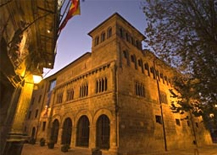
Locality: PAMPLONA (31001)
Address: Avenida Avda. Carlos III, 1
Zone: The Pamplona Basin
Style: Neoclassical
Centuries of construction: XIX
Visiting hours: Sólo se ofrece visita guiada para entidades y grupos. El horario de visita es de lunes a viernes, a las 15:30. Cerrado del 22 de diciembre al 9 de enero y los meses de julio, agosto y primera quincena de septiembre
Price of the visit: Gratuito
Telephones: 848427000 – 848427100
Description
In the heart of Pamplona, between the Plaza del Castillo and the Paseo de Sarasate, stands the Palacio de Navarre, seat of the Presidency of the Regional Government and a number of administrative offices of Navarre. The complex, designed by José de Nagusia in 1840, is a palatial building in a serious, powerful and solemn neo-Classical style that is surrounded by several columns.
Of the interior the majesty and splendour of the zona noble stands out, with the Throne Room and exuberant decoration as a symbol of power. In the office of the President of the Government of Navarre, another of the most luxurious rooms in the Palace, there are two jewels in particular: a portrait of King Ferdinand VII by Goya, and a large tapestry depicting the great battle of Navas of Tolosa (1212).
The garden contains a giant sequoia, the tallest tree in the city. The Palacio de Navarre, popularly known as the “Diputación”, is the seat of the regional government. Built in the neoclassical style, one of its facades looks out onto the Monumento de los Fueros (Charter Monument) in the Paseo de Sarasate and the other onto Avenida Carlos III and the Plaza del Castillo, the main square of the city.
The main front is crowned by a set of sculptures by Fructuoso Orduna (1951) that includes the coat of arms of Navarre flanked by two men: one from the mountains in the north and the other from the plains in the south. Two niches contained the bronze figures of Kings Sancho VII ?el Fuerte’ and Sancho ?el Mayor’. The porches of this facade still show shell holes from the Spanish Civil War.
The Garden
The garden, surrounded by railings next to the main facade, contains the old General Archives of Navarre. The tallest tree in the city stands there: a 37-metre-high sequoia with a perimeter of 7 metres. It is 150 years old and was brought from the America by José María Gastón y de Echevetz, who planted it in the Palace gardens when he was elected as a member of the Parliament of Navarre in 1855.
The other facade, built later, is the work of the architect brothers José and Javier Yárnoz, and gives onto Avenida Carlos III opposite the Teatro Gayarre. It was created to open up the area to the Plaza del Castillo, and its sober structure is similar to that of the main front.
Inside
There is an interesting collection of paintings and murals, most of them from the 19th and 20th centuries, which represent different moments of the history of Navarre, that can be found in the rooms and corridors of this three-storey building.
The “Salón del Trono” (Throne Room) on the noble floor, is adorned with marble, velvet, glass, coats of arms, mirrors, chandeliers, candelabras, gilded stucco, vases and other decorative features.
There are eight oil paintings by Francisco de Aznar, Alejandro Ferrant and Constantino Corona, as well as 32 portraits of the Kings of Navarre and other paintings and tapestries from the 17th century on historical themes.
The palace also has a Chapel, which was an ancient royal chamber.
The noble floor is completed with the President’s Office; the Antechamber, with a portrait of the Prince of Viana; the Presidents’ Room, the Green Room, the Cabinet Room and the Isabelline Room. Most of the canvases and murals on display in the Palace are of illustrious kings and other figures. As well as the portrait of Ferdinand VII by Goya, others are of Queen María Cristina or Isabel II as a child by Antonio M. Esquivel.
Every day at 12 noon the clock of the Palace plays the Hymn of Navarre, a melody that can be heard in all the streets around the building, which make up the busiest and most commercial part of the city. It is very much a singing clock, as at Christmas and during the festivity of San Fermín it interprets carols or Navarrese songs, as the occasion requires.







